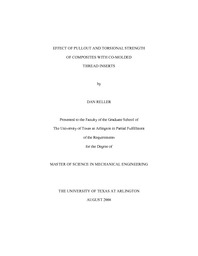
ATTENTION: The works hosted here are being migrated to a new repository that will consolidate resources, improve discoverability, and better show UTA's research impact on the global community. We will update authors as the migration progresses. Please see MavMatrix for more information.
Show simple item record
| dc.contributor.author | Reller, Dan L. | en_US |
| dc.date.accessioned | 2009-09-16T18:19:11Z | |
| dc.date.available | 2009-09-16T18:19:11Z | |
| dc.date.issued | 2009-09-16T18:19:11Z | |
| dc.date.submitted | January 2008 | en_US |
| dc.identifier.other | DISS-10000 | en_US |
| dc.identifier.uri | http://hdl.handle.net/10106/1748 | |
| dc.description.abstract | Rotorcraft transmission housings and drive system components are typically made from cast metals due to their highly complex geometries. Utilizing composite materials offers potential to reduce weigh and manufacturing cost while increasing corrosive resistance and extending part life. Traditional compression molded composites have not been utilized in aerospace because they typically experience low fiber volume fraction. Currently there are numerous materials which offer opportunities for composites in drive system housing applications and also offer the ability to co-mold details to reduce post mold operations. One of the issues associated with composite structures is the ability to fasten them to one another and to metallic structures because of issues concerning corrosion. Directly threading homogeneous materials, such as aluminum, produces strong threads; however, non-homogeneous based materials such as carbon fibrous composites raise concern about permanently damaging the structure or not providing enough holding strength to maintain structural integrity. Co-molding metallic inserts into a composite structure not only reduce part labor costs, but could also eliminate much of the thread strength concerns because thread shear is transferred through the homogeneous material. Unlike composite machining operations, there is no localized damage to the material. Co-molding inserts into composite structures has been done using processes such as Resin Transfer Molding (RTM) but the process comes with challenges. This thesis intends to experimentally observe composite fiber behavior associated with co-molded insert geometry and the effects on mechanical strengths, namely torsion and pullout. Co-molding processes often induce fiber waviness. The presence of fiber waviness reduces structural stiffness, strength and fatigue life. The lack of a mechanical strength database associated with co-molded inserts in composite molding compounds leads to a comparison with co-molded continuous fiber specimens and traditional tapped laminates. The measures of success for co-molded inserts in composite compression molded panels include pullout and torsional strength compared to the continuous fiber traditional materials specimen with embedded inserts. | en_US |
| dc.description.sponsorship | Chan, Wen | en_US |
| dc.language.iso | EN | en_US |
| dc.publisher | Mechanical Engineering | en_US |
| dc.title | Effect Of Pullout And Torsional Strength Of Composites With Co-molded Thread Inserts | en_US |
| dc.type | M.S. | en_US |
| dc.contributor.committeeChair | Chan, Wen | en_US |
| dc.degree.department | Mechanical Engineering | en_US |
| dc.degree.discipline | Mechanical Engineering | en_US |
| dc.degree.grantor | University of Texas at Arlington | en_US |
| dc.degree.level | masters | en_US |
| dc.degree.name | M.S. | en_US |
| dc.identifier.externalLink | http://www.uta.edu/ra/real/editprofile.php?onlyview=1&pid=229 | |
| dc.identifier.externalLinkDescription | Link to Research Profiles | |
Files in this item
- Name:
- Reller_uta_2502M_10000.pdf
- Size:
- 6.484Mb
- Format:
- PDF
This item appears in the following Collection(s)
Show simple item record


